
Halictidae is the second-largest family of bees with nearly 4,500 species. They are commonly called sweat bees, as they are often attracted to perspiration. Halictid species are an extremely diverse group that can vary greatly in appearance. These bees occur all over the world and are found on every continent except Antarctica. Usually dark-colored and often metallic, halictids are found in various sizes, colors and patterns. Several species are all or partly green and a few are red, purple, or blue. A number of them have yellow markings, especially the males, which commonly have yellow faces, a pattern widespread among the various families of bees. The family is one of many with short tongues and is best distinguished by the arcuate basal vein found on the wing. Females in this family tend to be larger than the males. They are the group for which the term 'eusocial' was first coined by entomologist, Suzanne Batra.

Halictus rubicundus, the orange-legged furrow bee, is a species of sweat bee found throughout the Northern Hemisphere. H. rubicundus entered North America from the Old World during one of two main invasions of Halictus subgenera. These invasions likely occurred via the Bering land bridge at times of low sea level during the Pleistocene epoch.

The genus Halictus is a large assemblage of bee species in the family Halictidae. The genus is divided into 15 subgenera, some of dubious monophyly, containing over 200 species, primarily in the Northern Hemisphere. Most species are black or dark brown, sometimes metallic greenish-tinted, with apical whitish abdominal bands on the terga.
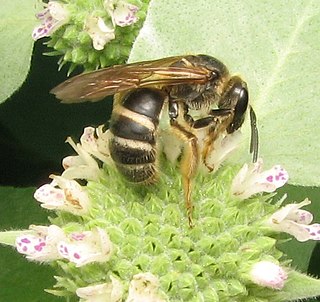
The sweat bee genus Lasioglossum is the largest of all bee genera, containing over 1800 species in numerous subgenera worldwide. They are highly variable in size, coloration, and sculpture; among the more unusual variants, some are cleptoparasites, some are nocturnal, and some are oligolectic. Most Lasioglossum species nest in the ground, but some nest in rotten logs.

Halictus scabiosae, the great banded furrow-bee, is a species of bee in the family Halictidae, the sweat bees.
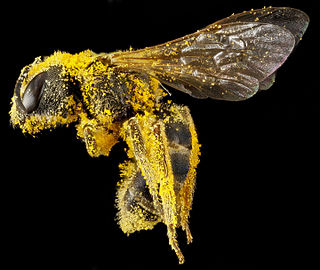
Halictus ligatus is a species of sweat bee from the family Halictidae, among the species that mine or burrow into the ground to create their nests. H. ligatus, like Lasioglossum zephyrus, is a primitively eusocial bee species, in which aggression is one of the most influential behaviors for establishing hierarchy within the colony, and H. ligatus exhibits both reproductive division of labor and overlapping generations.

Anelaphus villosus, the twig pruner, is a species in the longhorn beetle family Cerambycidae. It is found in the eastern half of the United States and southeastern Canada.

Halictus gemmeus is a species of bee in the family Halictidae, the sweat bees.
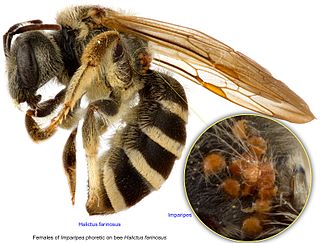
Halictus farinosus is a species of ground-nesting sweat bee in the family Halictidae. The species is a primitively eusocial bee, of intermediate social strength when compared to other social species in the genus Halictus.

Hoplitis is a genus of bees in the family Megachilidae. There are more than 380 described species in Hoplitis.
Ataeniopsis is a genus of aphodiine dung beetles in the family Scarabaeidae. There are about 15 described species in Ataeniopsis.

Halictus tripartitus is a species of sweat bee in the family Halictidae. It is partially eusocial, with nests connected underground and some workers capable of reproducing.
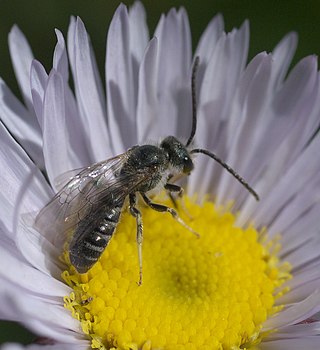
Halictus virgatellus is a species of sweat bee in the family Halictidae.

Halictus confusus, the southern bronze furrow bee or confused sweat bee, is a species of sweat bee in the family Halictidae. It is a primitively eusocial bee species found in open habitats in Eurasia and North America.

Stigmus is a genus of aphid wasps in the family Crabronidae. There are more than 20 described species in Stigmus.
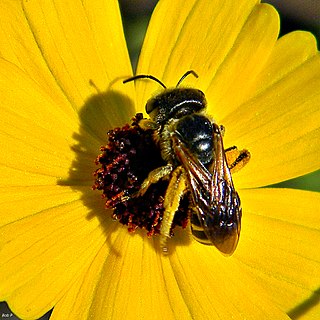
Halictus poeyi, or Poey's furrow bee, is a species of sweat bee in the family Halictidae. It is found in the southeastern United States, and is morphologically indistinguishable from Halictus ligatus.
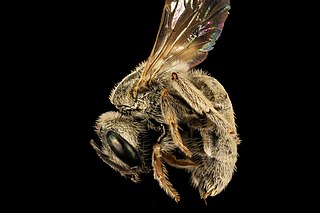
Halictus tectus is a species of sweat bee in the family Halictidae.
Lasioglossum mellipes is a species of sweat bee in the family Halictidae.
Halictus hotoni, Hoton's metallic-furrow bee, is a species of sweat bee in the family Halictidae native to southern Africa and introduced to Australia. It was initially identified as the Emerald metallic-furrow bee It was described by Joseph Vachal in 1903.















